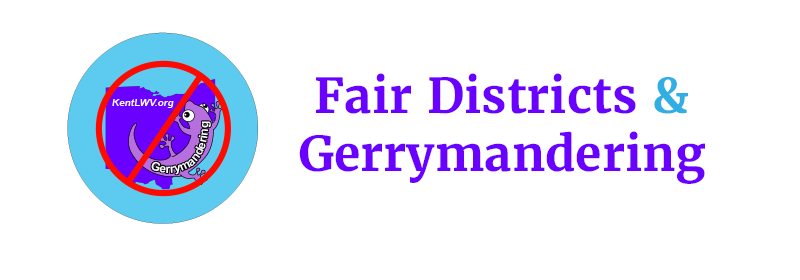
Gerrymandering
Gerrymandering can take place in two ways that are closely linked:
-
Racial gerrymandering occurs when a district is created with intentional manipulation to decrease the political power of a particular racial group or groups.
-
Partisan gerrymandering takes place when districts are created to give an unfair advantage to a particular political party, incumbent or group.
“Gerrymandering is not a Republican or Democrat problem. It is a fundamental problem of government that must be corrected.”
Former Ohio Gov. James Rhodes
Fair Maps/Redistricting
When talking about redistricting, “fair maps” refers to creating districts that will protect the interests of the people and their communities.
Representatives of all the people should participate in the redistricting process.
“If we are to be a great democracy, we must all take an active role in our democracy.”
Martin Luther King III
The Redistricting Process
Every 10 years new census numbers are used to create new districts. A process called apportionment takes the total number in the census and divides that by the number of seats in Congress (currently 435).
Redistricting takes the number of people per seat or district to draw lines that are substantially equal in population. Even if the number of districts does not change, governments must redraw districts so each one has equal populations.
Redistricting Process
Every redistricting process should include:
-
Specific timelines for the steps leading to a redistricting plan;
-
Full disclosure throughout the process and public hearings on the proposed plan;
-
Be conducted in an open, unbiased manner with citizen participation and access at all levels and steps of the process; and
-
Should be subject to open meeting laws.
Rules from the 2018 legislation for congressional maps were designed to prevent some of the more negative aspects of Gerrymandering and include these requirements:
-
Bipartisan map making
-
Greater transparency
-
Public engagement
-
Emphasize counties as political building blocks
-
Decrease the splitting of counties (in the past many counties were split more than three times)
-
Protect against drawing district lines to favor or disfavor political party candidates and incumbents.
Timeline
June- August 2021
Public Hearings of the Ohio Redistricting Commission and the state legislature
September 1, 2021
Deadline for Ohio House and Ohio Senate legislative district maps (Mapmakers: Ohio Redistricting Commission)
September 30
Date delayed US Census data is expected to arrive.
Stage 1: Deadline for 10-year congressional districts
(Mapmakers: the state legislature)
Maps must have the approval of 60% of the members of the Ohio General Assembly and 50% of the minority party's member
October 30
Stage 2: Deadline for 10-year congressional districts
(Mapmakers: Ohio Redistricting Commission)
Maps must have the approval of the majority of the members (four out of seven) and two members each from Democrats and Republicans
November 30
Stage 3: Deadline for 10-year congressional districts
(Mapmakers: the state legislature)
Maps must have the approval of 60% of the members of the Ohio General Assembly and one-third of the minority party's members
If the maps from Stage 3 are not approved, then the process moves to
Stage 4: Deadline for 4-year congressional districts
(Mapmakers: the state legislature)
Maps must have the approval of a majority of the members of the Ohio General Assembly, with additional requirements.
Why is the League of Women Voters involved?
As voters in Ohio, we need to demand fair play and common sense in redrawing legislative lines. The redistricting process must be compact, fair, respect county and municipal boundaries, and promote competitiveness. It is time for voters to choose their representatives, not allow representatives to choose their voters.
Whether you consider yourself a Republican, Democrat or have no party affiliation, fair districts impact what you care about in your community. Your voice is needed to help prevent public officials from drawing districts that are not representative of our communities.
What can you do?
Contact your legislators and let them know you support democracy as it was intended in Ohio. Public involvement with the redistricting process will help ensure Ohioans end up with fair districts. For more information: www.fairdistrictsohio.org.